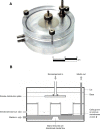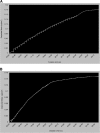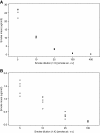Real-time assessment of cigarette smoke particle deposition in vitro
- PMID: 22958446
- PMCID: PMC3443673
- DOI: 10.1186/1752-153X-6-98
Real-time assessment of cigarette smoke particle deposition in vitro
Abstract
Background: Recently there has been a rapid increase in approaches to assess the effects of cigarette smoke in vitro. Despite a range of gravimetric and chemical methods, there is a requirement to identify simpler and more reliable methods to quantify in vitro whole smoke dose, to support extrapolation and comparisons to human/in vivo dose. We have previously characterised an in vitro exposure system using a Borgwaldt RM20S smoking machine and a chamber exposing cellular cultures to whole smoke at the air-liquid interface. In this study we demonstrate the utility of a quartz crystal microbalance (QCM), using this exposure system, to assess real-time cigarette smoke particulate deposition during a 30 minute smoke exposure. Smoke was generated at various dilutions (1:5-1:400, smoke:air) using two cigarette products, 3R4F Kentucky reference and 1 mg commercially available cigarettes. The QCM, integrated into the chamber, assessed particulate deposition and data generated were compared to traditional chemical spectrofluorometric analysis.
Results: The QCM chamber was able to detect mass differences between the different products within the nanogram range. 3R4F reference cigarette smoke deposition ranged from 25.75 ±2.30 μg/cm2 (1:5) to 0.22 ±0.03 μg/cm2 (1:400). 1 mg cigarette smoke deposition was less and ranged from 1.42 ±0.26 μg/cm2 (1:5), to 0.13 ±0.02 μg/cm2 (1:100). Spectrofluorometric analysis demonstrated statistically significant correlation of particulate deposition with the QCM (p < 0.05), and regression R2 value were 97.4 %. The fitted equation for the linear model which describes the relationship is: QCM = -0.6796 + 0.9744 chemical spectrofluorescence.
Conclusions: We suggest the QCM is a reliable, effective and simple tool that can be used to quantify smoke particulate deposition in real-time, in vitro and can be used to quantify other aerosols delivered to our chamber for assessment.
Figures





References
-
- Perfetti TA, Rodgman A. The Complexity of Tobacco and Tobacco Smoke. Beitr. 2011;24:215–232.
-
- Chalupowicz DG, Frankowski R, Sanchez Y, Kou J, Barnette M, Walsh PT. Cellular responses of primary human bronchial epithelial cells to whole cigarette smoke exposure. Amer. 2008;177:199.
LinkOut - more resources
Full Text Sources
Other Literature Sources

